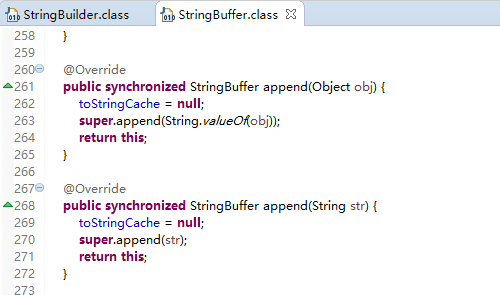测试代码:
public class StringJoinTest { public static void main(String[] args) { int count = 10000; long begin, end, time;
begin = System.currentTimeMillis(); testString(count); end = System.currentTimeMillis(); time = end - begin; System.out.println("拼接" + count + "次,String消耗时间:" + time + "毫秒"); begin = System.currentTimeMillis(); testStringBuffer(count); end = System.currentTimeMillis(); time = end - begin; System.out.println("拼接" + count + "次,StringBuffer消耗时间:" + time + "毫秒"); begin = System.currentTimeMillis(); testStringBuilder(count); end = System.currentTimeMillis(); time = end - begin; System.out.println("拼接" + count + "次,StringBuilder消耗时间:" + time + "毫秒"); } private static String testStringBuilder(int count) { StringBuilder tem = new StringBuilder(); for (int i = 0; i < count; i++) { tem.append("hello world!"); } return tem.toString(); } private static String testStringBuffer(int count) { StringBuffer tem = new StringBuffer(); for (int i = 0; i < count; i++) { tem.append("hello world!"); } return tem.toString(); } private static String testString(int count) { String tem = ""; for (int i = 0; i < count; i++) { tem += "hello world!"; } return tem; } }
测试结果:



结论:
在少量字符串拼接时还看不出差别,但随着数量的增加,String+拼接效率显著降低。在达到100万次,我本机电脑已经无法执行String+拼接了,StringBuilder效率略高于StringBuffer。所以在开发过程中通常情况下推荐使用StringBuilder。
StringBuffer和StringBuilder的区别在于StringBuffer是线程安全的。
